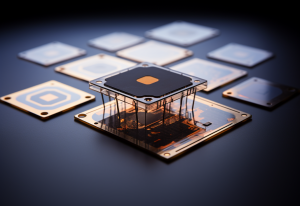Introduction
In the rapidly advancing landscape of semiconductor technology, Physical Vapor Deposition (PVD) stands as a pivotal tool for achieving precision and efficiency in thin film deposition processes. This article is a comprehensive exploration of the advanced applications of PVD technology within the semiconductor industry, offering a detailed examination of its diverse applications, supported by examples and case studies.
Understanding PVD in Semiconductor Manufacturing
Physical Vapor Deposition involves the deposition of thin films on semiconductor substrates, utilizing physical processes such as sputtering or evaporation. PVD’s versatility and controllability make it an invaluable tool in semiconductor manufacturing, enabling the creation of complex and high-performance devices.
Applications in Advanced Microelectronics
Thin Film Transistors (TFTs):
PVD plays a pivotal role in the fabrication of TFTs, a fundamental component in flat-panel displays, organic light-emitting diodes (OLEDs), and other emerging display technologies. PVD techniques enhance TFT performance, improve response times, and reduce power consumption, contributing significantly to the evolution of display technologies.

Interconnects and Metallization:
As semiconductor devices become more compact, efficient interconnects are crucial. PVD aids in creating reliable metal interconnects with minimal resistivity, enhancing signal speed and device reliability. Case studies will illuminate the critical role of PVD in advanced metallization processes, ensuring optimal device performance.
Semiconductor Packaging:
PVD is instrumental in the production of protective coatings for semiconductor devices, safeguarding them against environmental factors and ensuring longevity. We will delve into how PVD contributes to the creation of protective layers that enhance device durability and reliability, especially in challenging operating environments.
Case Studies and Real-World Examples
PVD in Logic and Memory Devices:
The implementation of Physical Vapor Deposition (PVD) in the fabrication of logic and memory devices has revolutionized semiconductor memory technologies. Let’s explore some real-world examples showcasing the impactful role of PVD in this domain.
1. High-Density Memory Storage:
In the realm of high-density memory storage, PVD techniques have been instrumental in pushing the boundaries of data storage capabilities. Case studies reveal instances where PVD is employed to deposit thin films with exceptional precision, enabling the creation of densely packed memory cells. This not only maximizes storage capacity but also enhances data retrieval speeds, contributing to the efficiency of memory devices.
2. Performance Enhancement in Logic Circuits:
Logic circuits form the backbone of semiconductor devices, and PVD plays a pivotal role in enhancing their performance. Through controlled deposition processes, PVD ensures the creation of high-quality interconnects and metal layers, reducing resistivity and improving signal propagation. Case studies highlight how PVD contributes to the fabrication of logic circuits with superior speed, reliability, and energy efficiency.

The precision and reliability offered by PVD technology are key factors in the continual advancement of semiconductor memory technologies, pushing the boundaries of what is achievable in terms of storage capacity and processing speeds.
PVD for Advanced Sensor Technologies:
The application of Physical Vapor Deposition (PVD) in the development of advanced sensor technologies has far-reaching implications across diverse sectors, including automotive, healthcare, and consumer electronics. Here are some illustrative examples highlighting the crucial role of PVD in this field.
1. Automotive Sensors:
In the automotive industry, sensors are essential components for various applications, including safety systems and engine management. PVD is employed to create thin films on sensor surfaces, enhancing sensitivity and response times. Real-world examples demonstrate how PVD contributes to the production of automotive sensors with increased accuracy, enabling advancements in driver assistance systems and overall vehicle safety.
2. Healthcare Sensors:
PVD plays a significant role in the development of sensors used in healthcare applications, such as medical imaging devices and diagnostic tools. Through precise deposition processes, PVD ensures the creation of sensor coatings that enhance sensitivity and biocompatibility. Case studies showcase how PVD contributes to the production of reliable and accurate healthcare sensors, ultimately improving patient care and diagnostic capabilities.
3. Consumer Electronics Sensors:
From touchscreens to motion sensors, consumer electronics rely on sensors for various functionalities. PVD technology is employed to create protective and conductive layers on sensor surfaces, improving durability and responsiveness. Examples highlight how PVD enhances the reliability of sensors in consumer electronics, contributing to the seamless and efficient operation of devices.
Conclusion
As semiconductor devices continue to evolve in complexity and functionality, the role of PVD in their fabrication becomes increasingly vital. This article has provided a comprehensive overview of the advanced applications of PVD technology in the semiconductor industry, offering a deeper understanding of its impact on the creation of cutting-edge electronic devices. Embracing the versatility of PVD opens new possibilities for innovation and ensures the semiconductor industry remains at the forefront of technological advancement.
For additional information on PVD, you can visit https://www.sputtertargets.net/.




